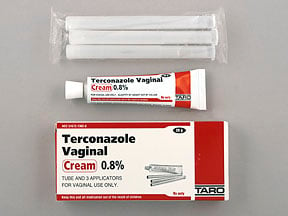
Terconazole Coupons & Savings Card – Discount Prices from $16.90
My prescription
Edit
20GM of 0.8%, Terconazole (1 Tube)
Select pharmacy

CVS
$27.72
COUPON PRICE
Walgreens
$16.90
COUPON PRICE
Walmart
$25.69
COUPON PRICE
Albertsons
$33.59
COUPON PRICEFree Terconazole Savings Card

Walgreens
$16.90
Show this coupon to your pharmacist
ID
LHF8AC871A
PCN
HT
BIN
011867
GRP
LABH001
This coupon is not insurance
Related azole antifungals prescriptions
More prescriptions for yeast infection
Related azole antifungals prescriptions
More prescriptions for yeast infection
Terconazole dosage forms
Dosage Quantity Price from Per unit 20GM of 0.8% 1 Tube $25.69 $25.69 20GM of 0.8% 2 Tubes $37.44 $18.72 20GM of 0.8% 3 Tubes $47.16 $15.72 45GM of 0.4% 1 Tube $23.58 $23.58 45GM of 0.4% 2 Tubes $29.16 $14.58 45GM of 0.4% 3 Tubes $34.74 $11.58
| Dosage | Quantity | Price from | Per unit |
|---|---|---|---|
| 20GM of 0.8% | 1 Tube | $25.69 | $25.69 |
| 20GM of 0.8% | 2 Tubes | $37.44 | $18.72 |
| 20GM of 0.8% | 3 Tubes | $47.16 | $15.72 |
| 45GM of 0.4% | 1 Tube | $23.58 | $23.58 |
| 45GM of 0.4% | 2 Tubes | $29.16 | $14.58 |
| 45GM of 0.4% | 3 Tubes | $34.74 | $11.58 |
Terconazole Warnings
This safety information provides essential warnings regarding the use of terconazole. Please read the details carefully and reach out to your healthcare provider with any questions or concerns.
Serious Allergic Reactions: Although uncommon, terconazole can cause severe allergic reactions. Symptoms might include anaphylaxis, characterized by rash, hives, difficulty breathing, or facial swelling. Another rare but serious reaction is toxic epidermal necrolysis (TEN), which presents as fever, painful rash, and skin peeling or blistering. If you experience any of these symptoms, seek medical help immediately. Your healthcare provider will likely discontinue the medication and suggest an alternative treatment.
Vaginal Use Only: Terconazole is intended for vaginal application only. Do not ingest or apply it to the eyes, nose, or ears. If accidental ingestion occurs, contact the Poison Control Center at 1-800-222-1222 immediately.
Potential for Other Vaginal Infections: If symptoms of a vaginal yeast infection, such as itching, irritation, or thick discharge, do not improve within 3 days of using terconazole, contact your healthcare provider. Additionally, if the infection persists after 7 days, further evaluation may be necessary to consider alternative treatments.
There are no specific contraindications listed for terconazole. Always consult your healthcare professional before starting any new medication.
Terconazole Side Effects
Common side effects:
- Headaches
- Vaginal burning
Less common but important to monitor:
- Vaginal pain
- Itching
- Body pain
- Menstrual cramps
- Fever
- Chills
- Stomach pain
Serious side effects:
- Severe allergic reaction
- Hives
- Blistering skin
- Difficulty breathing
- Swelling of the face or throat
